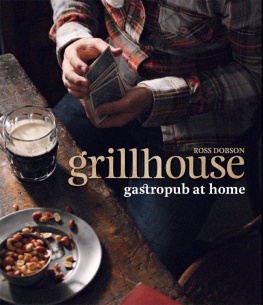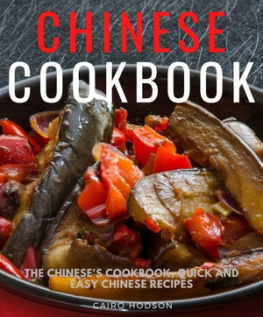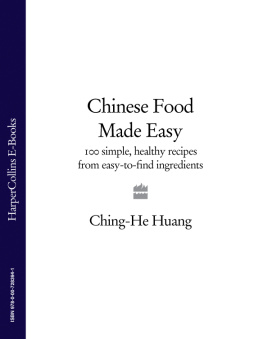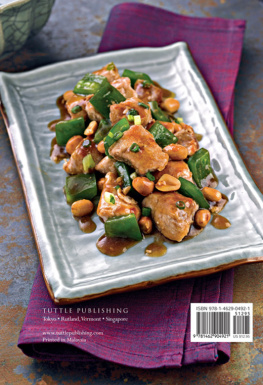Ross Dobson - Chinese Food Made Easy
Here you can read online Ross Dobson - Chinese Food Made Easy full text of the book (entire story) in english for free. Download pdf and epub, get meaning, cover and reviews about this ebook. year: 2019, publisher: Allen & Unwin, genre: Home and family. Description of the work, (preface) as well as reviews are available. Best literature library LitArk.com created for fans of good reading and offers a wide selection of genres:
Romance novel
Science fiction
Adventure
Detective
Science
History
Home and family
Prose
Art
Politics
Computer
Non-fiction
Religion
Business
Children
Humor
Choose a favorite category and find really read worthwhile books. Enjoy immersion in the world of imagination, feel the emotions of the characters or learn something new for yourself, make an fascinating discovery.
- Book:Chinese Food Made Easy
- Author:
- Publisher:Allen & Unwin
- Genre:
- Year:2019
- Rating:3 / 5
- Favourites:Add to favourites
- Your mark:
- 60
- 1
- 2
- 3
- 4
- 5
Chinese Food Made Easy: summary, description and annotation
We offer to read an annotation, description, summary or preface (depends on what the author of the book "Chinese Food Made Easy" wrote himself). If you haven't found the necessary information about the book — write in the comments, we will try to find it.
Chinese Food Made Easy — read online for free the complete book (whole text) full work
Below is the text of the book, divided by pages. System saving the place of the last page read, allows you to conveniently read the book "Chinese Food Made Easy" online for free, without having to search again every time where you left off. Put a bookmark, and you can go to the page where you finished reading at any time.
Font size:
Interval:
Bookmark:









Canton is the former name of Guangzhou, the capital city of Guangdong Province. This region covers Hong Kong and part of mainland China. Guangzhou, Anhui, Fujian, Hunan, Jiangsu, Shandong, Szechuan and Zhejiang make up the eight culinary regions of China. Like a tapestry, the cuisine of each region can be linked by the common thread of an ingredient or two. Yet, each region will have a distinctive and unique combination of ingredients and cooking techniques. Some differences are subtle.
Some, not so. In the cold, landlocked regions of the north, lamb and wheat-based noodles and breads dominate. Further west, the spices we associate with Indian and Middle Eastern cooking, such as cumin and dried chilli, are used to flavour lamb and beef. Meat is simply spiced and skewered, shish kebab style, then grilled or barbecued. From the south central region of Hunan, the birthplace of Chairman Mao, comes the sweet and unctuous technique of red braising; fragrant with star anise, cinnamon quills and dark soy sauce to impart a deep caramel colour. Red-braised pork belly, sometimes called Chairman Maos pork, has folklore status.
The dish is credited with Maos political success. In the north-east, the food is referred to as Imperial Court cuisine. This is the home of Peking roast duck, delicately sliced so each sliver will have the perfect balance of skin, fat and meat. The slices are wrapped in wafer-thin pancakes with crisp cucumber and spring onions. The green spring onion ends are shredded and soaked in water so that they curl up like a brush. The intent is just that they are used as a brush to apply the accompanying barbecue sauce to the pancake, before being wrapped in the pancake and eaten.
This is an edible example of form following function. Very little goes to waste in the Chinese kitchen. Szechuan, synonymous with the pepper, is a cuisine defined by a flavour called ma la , meaning numbing and hot. The tingling numbness comes from Szechuan pepper and the heat from prolific use of dried chillies. Sesame, seeds and oil, also makes its presence felt in the food from this region. The provinces of the east coast use these well-known ingredients: black beans, hoi sin and plum sauces.
Fresh ginger, garlic and spring onions are the celestial trinity of seasonings that kick-start a stir-fry in hot woks wrapped in flames. Here, the cacophonous clang of metal on metal is considered an essential part of good cooking. The food from the regions of China are not only linked by ingredients and technique. Regardless of where you are, dishes all over China are often given seemingly incongruous names. Ants climbing tree or lions head meatballs are intriguing names for dishes that are delicious nonetheless. Food in China is sometimes elevated to heavenly status.
The symbolism is as much part of the food tradition as anything else. THE CULINARY TREASURES OF CHINA GUANGDONG & HONG KONG Due to the large number of emigrants from this region, this is the style of food that many people think of as quintessentially Chinese. Most of us will know it as Cantonese. Simple steamed rice replaces wheat noodles or bread and is consumed in abundance. Steamed whole fish with ginger and spring onions, hot fresh vegetable stir-fries, bamboo baskets filled with steamed dumplings, noodle soups with barbecue pork and roasted meats. FUJIAN This is a relatively small region on the coast.
Seafood is dominant and much of the food is presented in a soup form. Exotic ingredients such as sharks fin, sea cucumber and dried scallops are included in Fujian dishes. A popular dish called Buddha jumps over the wall is supposedly so delicious that Buddha himself would jump a wall to get to eat it. ZHEJIANG It is said that this is the most refined of Chinas cuisines. Fresh seafood and meat are lightly flavoured with vinegar and soy sauce. You will be hard-pressed to find any spice or chilli in the dishes of this region.
Slow-simmered, perfectly cubed pieces of pork in a rich broth is known as dongpo pork and reflects the finery of this cuisine. This region is also the home of baked chicken known as beggars chicken or clay-wrapped chicken. JIANGSU The wealth of the Shanghai economy makes this region one of the most affluent in China. With access to the coast and rivers, seafood is a common and popular ingredient. The best known dish to hail from this region must be classic, or Yangzhou, fried rice. A combination of chopped ham or sausage, spring onions and eggs are quickly stir-fried with rice, soy sauce and sesame oil.
SHANDONG The birthplace of Confucius, this culinary region is on the north-east coast of China. Hearty food is popular here, such as wheat dough dumplings. These are not small delicate dumplings, but can be the size of a small hand and are filled with richly flavoured pork. Vinegar and ginger dipping sauces are served alongside the dumplings. ANHUI The food here is often described as hearty mountain peasant food. This landlocked region is bordered by the other more famous food regions of China and takes its culinary cue from the influences of Shandong, Jiangsu and Zhejiang.
Braising, stewing and smoking are popular cooking techniques. Anhui is home to a delicious dish called Fuliji poached chicken chicken coated in sweet syrup and flash fried in oil, then simmered in a rich stock. HUNAN Also known as Xiang cuisine, the food here is a reflection of the rich diversity and abundance of agriculture and produce of this region. Garlic, ginger and chilli are used with a heavy hand and give this cuisine its reputation for dry and hot food, known as la . A signature dish is called farmer pepper pork tender pork belly stir-fried with green capsicums and fermented black beans. SZECHUAN Dishes here are defined by Szechuan peppercorns and dried red chillies.
Font size:
Interval:
Bookmark:
Similar books «Chinese Food Made Easy»
Look at similar books to Chinese Food Made Easy. We have selected literature similar in name and meaning in the hope of providing readers with more options to find new, interesting, not yet read works.
Discussion, reviews of the book Chinese Food Made Easy and just readers' own opinions. Leave your comments, write what you think about the work, its meaning or the main characters. Specify what exactly you liked and what you didn't like, and why you think so.









